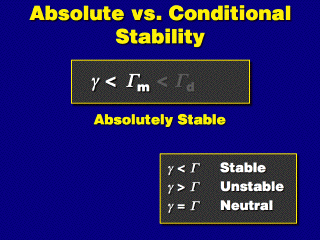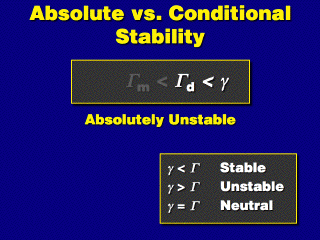Given that the dry
and moist adiabatic lapse rates are different, it is possible for a parcel
in equilibrium to act differently after being disturbed, depending on whether
it is unsaturated or saturated. Remember, the dry adiabatic lapse rate applies
for an unsaturated parcel, the moist adibatic lapse rate for the saturated parcel.
 If the environmental
lapse rate is less than the moist adiabatic lapse rate (and by default, less
than the dry rate), the parcel is in stable equilibrium regardless of whether
it is saturated or unsaturated (recall the criterion that environmental
lapse rate < adiabatic lapse rate for stable conditions). So, the atmosphere
is absolutely stable---it is stable for any parcel condition.
If the environmental
lapse rate is less than the moist adiabatic lapse rate (and by default, less
than the dry rate), the parcel is in stable equilibrium regardless of whether
it is saturated or unsaturated (recall the criterion that environmental
lapse rate < adiabatic lapse rate for stable conditions). So, the atmosphere
is absolutely stable---it is stable for any parcel condition.
 If
the environmental laspe rate is greater than the dry adiabatic lapse rate (and
by default, greater than the moist rate), the parcel in unstable equilibrium
regardless of whether is is saturated or unsaturated (recall that environmental
lapse rate > adiabatic lapse rate for unstable conditions). So, the atmosphere
is absolutely unstable---it is unstable for any parcel condition.
If
the environmental laspe rate is greater than the dry adiabatic lapse rate (and
by default, greater than the moist rate), the parcel in unstable equilibrium
regardless of whether is is saturated or unsaturated (recall that environmental
lapse rate > adiabatic lapse rate for unstable conditions). So, the atmosphere
is absolutely unstable---it is unstable for any parcel condition.
 When
the environmental lapse rate is between both adiabatic lapse rates, then we
have an interesting condition. Since the environmental lapse rate is greater
than the moist adiabatic lapse rate, a saturated parcel would be in unstable
equilibrium. However, if the parcel is unsaturated, we use the fact that the
environmental lapse rate is less than the dry adiabatic lapse rate, which suggests
that the parcel is in stable equilibrium. The atmosphere is described as conditionally
unstable---it is stable or unstable depending on whether the air is unsaturated
or saturated, respectively.
When
the environmental lapse rate is between both adiabatic lapse rates, then we
have an interesting condition. Since the environmental lapse rate is greater
than the moist adiabatic lapse rate, a saturated parcel would be in unstable
equilibrium. However, if the parcel is unsaturated, we use the fact that the
environmental lapse rate is less than the dry adiabatic lapse rate, which suggests
that the parcel is in stable equilibrium. The atmosphere is described as conditionally
unstable---it is stable or unstable depending on whether the air is unsaturated
or saturated, respectively.



 If the environmental
lapse rate is less than the moist adiabatic lapse rate (and by default, less
than the dry rate), the parcel is in stable equilibrium regardless of whether
it is saturated or unsaturated (recall the criterion that environmental
lapse rate < adiabatic lapse rate for stable conditions). So, the atmosphere
is absolutely stable---it is stable for any parcel condition.
If the environmental
lapse rate is less than the moist adiabatic lapse rate (and by default, less
than the dry rate), the parcel is in stable equilibrium regardless of whether
it is saturated or unsaturated (recall the criterion that environmental
lapse rate < adiabatic lapse rate for stable conditions). So, the atmosphere
is absolutely stable---it is stable for any parcel condition. If
the environmental laspe rate is greater than the dry adiabatic lapse rate (and
by default, greater than the moist rate), the parcel in unstable equilibrium
regardless of whether is is saturated or unsaturated (recall that
If
the environmental laspe rate is greater than the dry adiabatic lapse rate (and
by default, greater than the moist rate), the parcel in unstable equilibrium
regardless of whether is is saturated or unsaturated (recall that  When
the environmental lapse rate is between both adiabatic lapse rates, then we
have an interesting condition. Since the environmental lapse rate is greater
than the moist adiabatic lapse rate, a saturated parcel would be in unstable
equilibrium. However, if the parcel is unsaturated, we use the fact that the
environmental lapse rate is less than the dry adiabatic lapse rate, which suggests
that the parcel is in stable equilibrium. The atmosphere is described as conditionally
unstable---it is stable or unstable depending on whether the air is unsaturated
or saturated, respectively.
When
the environmental lapse rate is between both adiabatic lapse rates, then we
have an interesting condition. Since the environmental lapse rate is greater
than the moist adiabatic lapse rate, a saturated parcel would be in unstable
equilibrium. However, if the parcel is unsaturated, we use the fact that the
environmental lapse rate is less than the dry adiabatic lapse rate, which suggests
that the parcel is in stable equilibrium. The atmosphere is described as conditionally
unstable---it is stable or unstable depending on whether the air is unsaturated
or saturated, respectively.